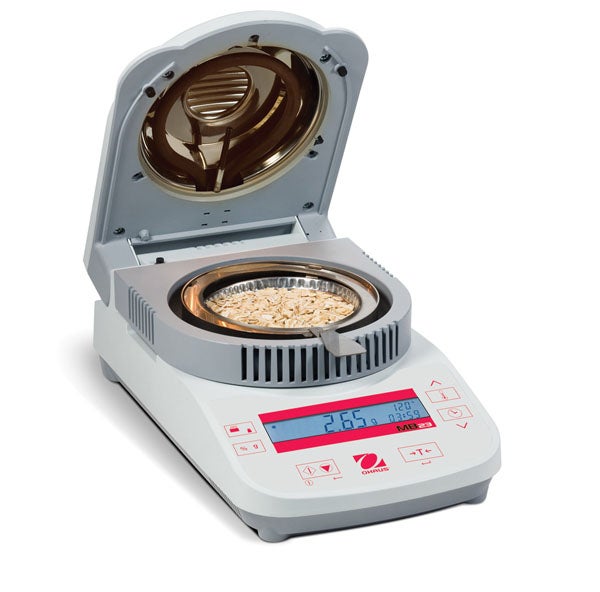Loading... 44 view(s)
Halogen versus Metal Heating
Thermogravimetric moisture analyzers efficiently dry a sample by transferring energy by both radiation (the transmission of energy in the form of waves or particles through a medium—in this case, the sample) and convection (heat transfer by mass motion). In comparison, a conventional drying oven uses mostly convection to dry a sample. Both metal and halogen heating
elements radiate energy in the infrared spectrum. (Both methods are employed in the OHAUS MB Series.)
Infrared (IR) radiation is part of the electromagnetic spectrum, falling between microwave energy and visible light. Infrared waves include thermal radiation and have the wavelength frequency range from 0.75 micrometers (long wavelength limit of visible red light) to 1.5 micrometers (borders on microwaves). Infrared energy is not visible to the human eye. The red light often associated with infrared heating is actually reflected red light from the visible spectrum.
 Some moisture analyzers utilize a metal heating element, which is simply a low-resistance piece of metal which converts electricity into heat. Such heaters are ideal for an environment (such as food processing) where the presence of glass components are prohibited due to regulatory or safety concerns. Metal heaters are not ideal as they have a very large thermal
mass and take significantly longer to heat up than halogen heaters, and are thereby harder to control and do not provide optimum reproducability in a moisture analyzer.
Halogen radiators have a tungsten heating element contained in a compact glass tube filled with halogen gas to preserve the tungsten element. The halogen radiator emits infrared radiation in the short wavelength range of 0.75–1.5 micrometers. The compact nature of the halogen radiator improves the heating/cooling response time, shortening the time for the heating unit to reach full heating power and ultimately shortening time requirements to complete sample drying; it also allows finer control during the heating process.
Some moisture analyzers utilize a metal heating element, which is simply a low-resistance piece of metal which converts electricity into heat. Such heaters are ideal for an environment (such as food processing) where the presence of glass components are prohibited due to regulatory or safety concerns. Metal heaters are not ideal as they have a very large thermal
mass and take significantly longer to heat up than halogen heaters, and are thereby harder to control and do not provide optimum reproducability in a moisture analyzer.
Halogen radiators have a tungsten heating element contained in a compact glass tube filled with halogen gas to preserve the tungsten element. The halogen radiator emits infrared radiation in the short wavelength range of 0.75–1.5 micrometers. The compact nature of the halogen radiator improves the heating/cooling response time, shortening the time for the heating unit to reach full heating power and ultimately shortening time requirements to complete sample drying; it also allows finer control during the heating process.

 Some moisture analyzers utilize a metal heating element, which is simply a low-resistance piece of metal which converts electricity into heat. Such heaters are ideal for an environment (such as food processing) where the presence of glass components are prohibited due to regulatory or safety concerns. Metal heaters are not ideal as they have a very large thermal
mass and take significantly longer to heat up than halogen heaters, and are thereby harder to control and do not provide optimum reproducability in a moisture analyzer.
Halogen radiators have a tungsten heating element contained in a compact glass tube filled with halogen gas to preserve the tungsten element. The halogen radiator emits infrared radiation in the short wavelength range of 0.75–1.5 micrometers. The compact nature of the halogen radiator improves the heating/cooling response time, shortening the time for the heating unit to reach full heating power and ultimately shortening time requirements to complete sample drying; it also allows finer control during the heating process.
Some moisture analyzers utilize a metal heating element, which is simply a low-resistance piece of metal which converts electricity into heat. Such heaters are ideal for an environment (such as food processing) where the presence of glass components are prohibited due to regulatory or safety concerns. Metal heaters are not ideal as they have a very large thermal
mass and take significantly longer to heat up than halogen heaters, and are thereby harder to control and do not provide optimum reproducability in a moisture analyzer.
Halogen radiators have a tungsten heating element contained in a compact glass tube filled with halogen gas to preserve the tungsten element. The halogen radiator emits infrared radiation in the short wavelength range of 0.75–1.5 micrometers. The compact nature of the halogen radiator improves the heating/cooling response time, shortening the time for the heating unit to reach full heating power and ultimately shortening time requirements to complete sample drying; it also allows finer control during the heating process.







